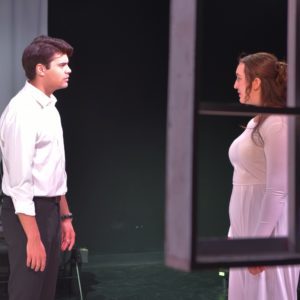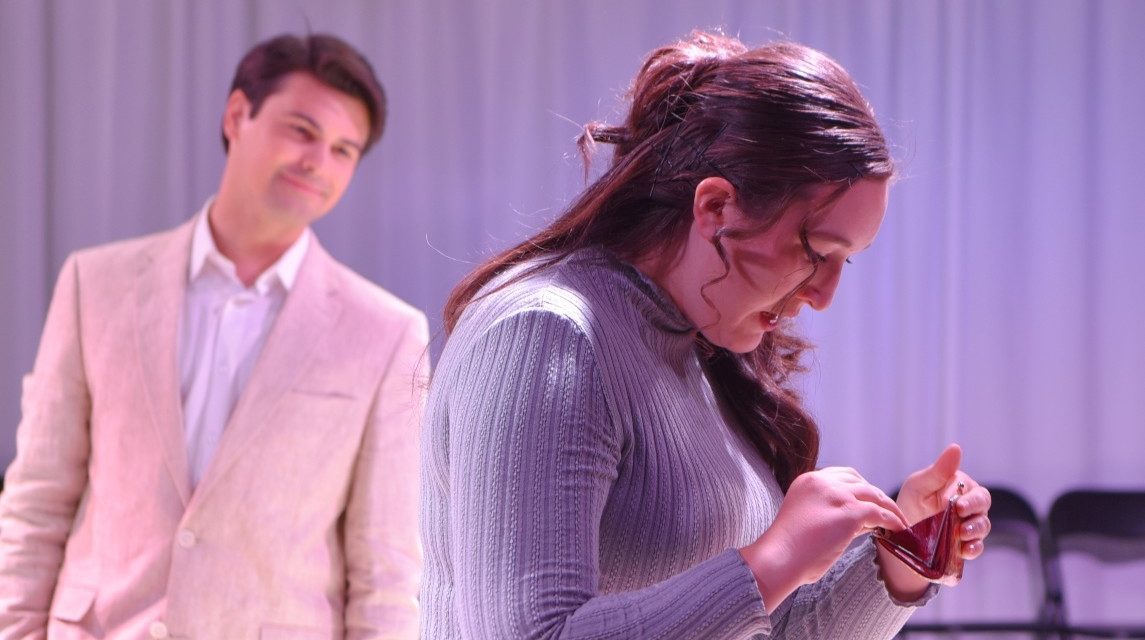PLEASANT GROVE — With its message of female liberation and protest against unequal opportunities for women, A Doll’s House shocked the world when it premiered in 1879. Now, over a century and three waves of feminism later, the play still holds an important lesson for its audience. Creekside Theatre Festival has mounted a respectable production of this classic play that injects some seriousness into a time of the year dominated by fluffy musicals and comedies.

Show closes June 24, 2022.
In A Doll’s House, middle-class couple Torvald and Nora Helmer are excited to celebrate both Christmas and Torvald’s new job as the manager of a bank. The position comes with a hefty increase in salary, and they are glad that their days of penny pinching are soon over. Privately, Nora is relieved that she will have enough money to finish paying off a loan that she secretly and illegally took out by forging her deceased father’s signature. Unfortunately, the lender, Nils Krogstad, is an employee at Torvald’s bank, and the new manager’s first order of business is to fire Krogstad. To save his job, he threatens to tell Torvald that Nora has broken the law, which would create a professional scandal for Torvald and a personal scandal for both.
Director Chris Hults has stripped this production to its bare bones. Staged in a black box theater, the set (designed by Brian Hadfield) consists of a large white rug, a white bench, three white tables topped with white props, two white chairs, and a white window frame. The costumes (designed by Katrina DeKarver) are modern and dominated by neutral tones. This spartan setting is a strength of the play: with the spectacle gone, the audience is forced to focus on Ibsen’s words and Nora’s gripping psychological turmoil.

Left to right: Trystyn Roberts as Torvald Helmer and Jeanelle Huff as Nora Helmer.
However, the bare designs are also the production’s greatest weakness. With the spectacle removed from the play, the actors and director have nowhere to run and nowhere to hide. Everything rides on the performances, and some of the actors are more capable of meeting the challenge than others.
Jeanelle Huff plays Nora with a tormented realism that never feels stagey. Nora’s palpable anxiety when worrying about Krogstad’s threats of blackmail, or her despair when she contemplates suicide are some of the best acting Utah County audiences can see on stage this month. Huff makes Nora adaptable, and the character can instantly turn on the charm and flightiness that her husband expects from a woman of the 19th century — making her change of behavior in the last scene believable. But that last scene loses some power when Huff’s performance is drained of much of that emotion; what is supposed to be a resolute Nora comes off instead as a disengaged Nora.
As Torvald, Trystyn Roberts gives a lively performance. His Torvald is not a sexist tyrant. Instead, he rules through enforcing cultural norms and engaging in benevolent sexism. The character means well, and Roberts exudes charm as he condescendingly calls Nora pet names. Roberts’s soft-spokenness is disarming, and this wise acting choice that makes Torvald’s dominance in the marriage subtle and stealthy. Once Torvald learns of Nora’s fraud, Roberts lets loose with a compelling performance where he — at one point or another — rages, pleads, reasons, and despairs. It is a very human performance that made me sympathize and condemn the character more than I ever had before.

Left to right: Jeanelle Huff as Nora Helmer and Sara Wilkins as Anne-Marie.
In contrast, Alex Glover (as Nils Krogstad) and Amber Ethington (as Christine Lind) were wooden in their performances. Ethington did little than recite her lines, and rarely reciprocated Huff’s emotional outpourings. All of Ethington’s reactions were muted, even when her character was supposed to be elated at getting a new job or shocked at Nora’s talk of suicide. Glover likewise delivered most of his lines in a consistent manner, making his performance fairly predictable after his first scene or two. I blame Glover’s subdued performance on the directing. For most of Glover’s time on stage, Hults kept him in a corner, talking quietly towards the other actors who were elsewhere on the stage. This prevented him from showing any male dominance over Nora and made Krogstad’s threats and intimidation seem distant.
Ironically, Glover and Ethington’s best scene was their final one, when their characters were on stage alone together. It was refreshing to see the two characters talk about something besides the Helmer family, and once Glover was freed from a corner of the stage, he could interact more meaningfully than he had in earlier scenes.
DeKarver’s costumes were consistent with the minimalism aesthetic of the other visual elements of the production, but they introduced a bit of confusion into the play. Many of the characters’ concerns are particular to Ibsen’s time: the terminal syphilis of Dr. Rank (played by Hults), laws banning Nora from receiving a loan, the delicate social position of widows, and more. Western societies have pretty much solved these problems. Setting A Doll’s House in the 21st century did not reduce the gulf between the 19th century and today, nor did it shine a light on the issues that concern many women today, such as sexual harassment in the workplace, the expense of child care, or access to health care.
Despite some flaws, Creekside’s production of A Doll’s House fills a need. Ibsen’s plays deserve to be seen more often in Utah, and the soberness of the production is a welcomed option at this time of year. I am grateful for Creekside from bringing A Doll’s House to the stage and hope that audiences will give the production a chance this month.





